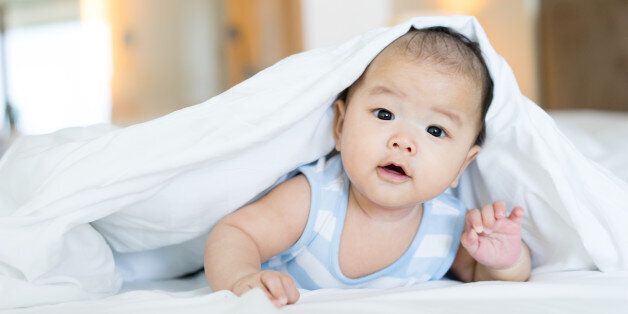
That's it - they're on the move! All hands on deck. The moment your baby is mobile, even if it's only a roll or a shuffle, they are at risk of harm in your home.
Those first steps, grasps and inquisitive forays are to be encouraged - they're all about your baby's vital development and progress. But that newfound freedom has to be protected, as you become more aware of potential dangers and make your house a safe place to explore.
The best way to do it is to take a slow tour around your home, get down on your knees to 'baby level', and look for the danger zones.
The living area:
Open fire places, heaters and woodburners - use a securely fixed fireguard.
Radiators - turn down the individual thermostats, and pull away furniture such as sofas where a baby could roll over and become wedged against one.
Coffee tables - put corner pads on sharp corners, and don't leave hot drinks on them, even for a second.
Smoke alarms - fit them on all floors, and test regularly.
Grab hazards - get down on the floor and check for anything a baby could pull over, such as lamps, ornaments or pot plants. Secure electrical cables and table cloths, and fasten freestanding units to walls.
DVD players and gadgets which could trap fingers - fit guards.
Doors - fit door-jammer devices for use during the day, but remove at night in case of fire.
The kitchen:
Stoves, hobs and ovens - use a stair gate to keep your baby away from cooking areas, or use a highchair or playpen.
Saucepans and frying pans - turn pans with their handles to the back of the stove so a baby can't reach them and tip them over. Consider fitting a hob guard. Keep the kettle pushed out of reach.
Sharp items, choking hazards and toxins - keep scissors or knives in cupboards or drawers fitted with locks. Keep all detergents, dishwasher tabs and household cleaning sprays locked away. Also store plastic or polythene bags out of reach, and be especially careful with lithium 'button' batteries, which look like sweets and cause severe internal damage.
The bathroom:
The bath - pour cold water in first when filling the tub, so the water is never scalding if a child is dropped or slips. Test with your elbow before putting your baby in (your hands can tolerate higher temperatures than a baby can). Install a thermostatic mixing valve to the taps if you can, or use a dip-in temperature gauge.
Loose items - ensure all medicines, toiletries and razors are locked away.
The bedroom:
Hot gadgets - be careful to keep hairdryers and hair straighteners out of reach.
Strangulation risks - tie dangling cords from blinds and curtains out of reach, and keep items with strings and ribbons away. Don't push beds against radiators.
The nursery:
Cot design - ensure cots adhere to safety standards regarding the gaps between the bars, that they don't have cut-outs and are not painted in old lead-based paint.
Climbing risks - push the cot away from direct sunshine, radiators, windows, furniture that can be used to climb on, dangly mobile toys and cords.
Sleep - don't use pillows, duvets or cot bumpers. Use a baby sleeping bag or removable layers of bedding. Make sure the mattress fits snugly with no gaps.
Changing - if you use a changing table, always stay with your baby while using it, or consider changing nappies on a mat on the floor. Keep nappy sacks and wet wipes out of reach.
The stairs:
Gates - fix safety gates top and bottom. The sort that screw to the wall are safer because they don't slip and don't have a bar across the bottom that could be a trip hazard.
Gaps - check banisters are secure and don't have gaps big enough for a baby to wiggle through - rememeber they can move backwards!
Trip hazards - keep stairs clear of clutter.
The windows:
Fall risks - fix locks or restricters to windows, but know how to open them quickly in case of fire. Keep chairs and other 'climbable' objects away from windows.
The garden:
The shed - make sure garden products, weedkillers, sharp utensils and electrical items are locked away.
The flora - don't let your baby put plants, berries or funghi in their mouth. Research poisonous plants or flowers in your garden, and remove.
Water - fence off garden ponds and swimming pools, or fill them in. Check access to neighbour's pools and ponds and secure your boundaries. Never leave a child unattended, even for a second, in water.
Finally, while you want to remove as many risks as possible from your home, you cannot always foresee every danger, and you also want to instil an awareness of risk and danger in your child which could protect them in other less regulated environments.
So get used to using short sharp warning words such as 'no', 'ouch', 'hot', 'sharp' and 'dangerous', said in a loud sharp voice, so your baby makes the right associations in a risky situation. This will set them up for safety both in your own home and outside it. To find out more about how to keep your children safe, take a look at Childcare.co.uk's parenting guides.